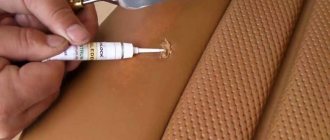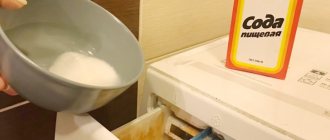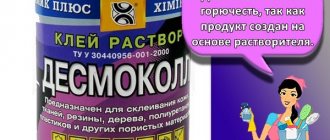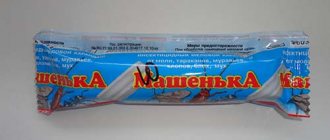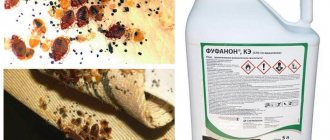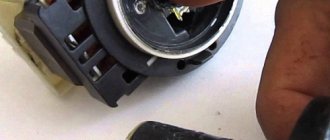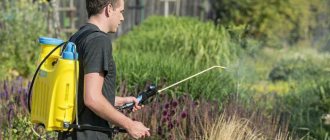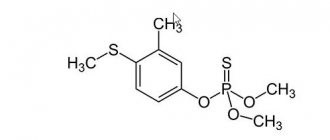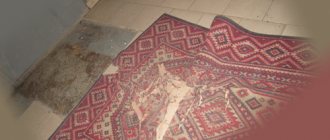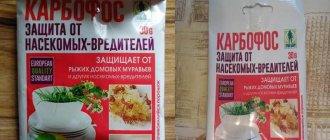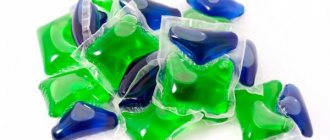Spectrum and principle of operation
"Karbofos" is used for use in agriculture against many types of harmful insects, stock pests and mites. And also for household use, for medical treatment of animals.
The active substance of the product, malathion, is highly toxic to insect pests. In their body, it turns into another, more toxic substance - malaoxon, which causes their death.
With frequent use of Karbofos, generations of pests can develop resistance to it and other FOS. Insects become capable of breaking down malathion into compounds that are harmless to them. The product is low-toxic for plants and does not change the taste and smell of fruits. "Karbofos" is used against gnawing and sucking insects, and is also effective against herbivorous mites.
Expert opinion
Zarechny Maxim Valerievich
Agronomist with 12 years of experience. Our best country expert.
Ask a Question
When using the insecticide in open beds, the drug has a short period of action (5-7 days) and is destroyed by water and wind. In greenhouse conditions, the protection period increases to 10 days.
Operating principle of Karbofos
Malathion is an insecticide from the group of organophosphorus compounds.
It is characterized by a lack of color, an oily structure, and a pronounced unpleasant odor. The substance is difficult to dissolve in water; solvents are used to obtain a uniform consistency. Hydrolysis (destruction) is promoted by liquid, but this process develops slowly under such conditions. Acid and alkaline environments accelerate the decomposition of the substance.
When malathion enters the body of blood-sucking parasites, it is converted, resulting in the release of another substance, malaoxone. It is noteworthy that the physiological activity of this compound is much higher. The process of converting malathion into malaoxon develops primarily in the body of blood-sucking and other insects.
This explains the moderate toxicity towards humans and a more aggressive effect on pests.
Another difference is that malathion hydrolyzes much more slowly after ingestion by insects. For this reason, the substance will remain in the body for a long time. However, the parasites will most likely die from prolonged exposure to the poison.
An interesting feature of malathion is that with the systematic use of such a substance, resistance to the poison develops in insects. In addition, when pests develop resistance, their bodies acquire the ability to break down the insecticide into simple components that do not have a toxic effect. In this case, malathion becomes useless.
In addition, against the background of developing resistance, insects acquire resistance to other substances of the organophosphate group.
With frequent use of this drug, bedbugs can get used to the poison
Effect of Karbofos on bedbugs, their larvae and eggs
The drug affects the nervous system of parasites.
It contributes to disruption of the transmission of nerve impulses. As a result, it becomes possible to quickly destroy bedbugs. They first lose the ability to move, eat, and stop reproducing. At the last stage, the pests die. Exactly the same effect is achieved when the poison enters the body of young individuals.
However, the larvae are more quickly exposed to the drug, which is due to the incompletely formed outer integument. In this case, the insecticide almost instantly corrodes the cuticle and easily penetrates the body. The outer covers of the larvae are formed in stages. The parasites shed their shells several times until they reach adult size. By that time, the cuticle is completely formed.
Karbofos has an ambiguous effect on bedbug eggs.
It is safe to say that it has a detrimental effect on all forms of life, however, such a remedy is not considered one of the effective against the offspring of bedbugs (protected by the shell). But the drug can still destroy some of the eggs.
The drug acts on the nervous system of parasites
Advantages and disadvantages
"Karbofos" has the following advantages:
- effectively destroys various types of pests, insects and mites;
- it can be used to process grains, fruits, berries, vegetables, fodder and oilseeds, pasture grasses;
- low dosage and consumption, economical.
See also
Instructions for use of Pirinex Super, insecticide dosage and analoguesRead
Disadvantages of the insecticide: toxicity to humans and bees, emergence of resistance in pests after frequent or systematic use.
How was Karbofos created?
The production of organophosphorus compounds, such as Karbofos, was carried out back in the 19th century. The chemical industry began to develop intensively in the 20th century. We were looking for additives for lubricants and toxic substances for agriculture. A. E. Arbuzov’s research played a major role in the creation of synthetic compounds, but they turned out to be very toxic.
Karbofos was obtained in the USSR in special laboratories. They worked on the creation of such substances in the West - in England, Germany and the USA. There this substance was called Malathion.
“Many new drugs have been invented to combat domestic parasites. They no longer have a smell, you don’t have to leave the apartment and take out all your things. But my parents stubbornly kill bedbugs and cockroaches with Karbofos. My father has a whole canister in his garage just in case. I don’t doubt there is a result. But it's too much trouble. When they invented it, they didn’t think about comfortable use. And they invented it for completely different purposes.”
Instructions for use of the drug "Karbofos"
Product dosage (in l per ha):
- cereals – 0.5-1.2;
- flax – 0.4-0.8;
- fruit – 1;
- raspberries – 1-2.6;
- cabbage – 0.6-1.2;
- alfalfa, clover, sainfoin – 0.2-0.6;
- sunflower, mustard – 0.6-0.8;
- pastures – 2-3;
- sea buckthorn cuttings – 1-1.4;
- sea buckthorn seedlings – 0.6-1.2.
Plants are sprayed against aphids, bugs, thrips, codling moths, cutworms, weevils, whiteflies, scale insects, sawflies, moths, mites, copperheads, gall midges, and moths.
The solution consumption for vegetables, grains, forage and pasture grasses is 200-400 l, for gardens - 1000-1500 l, bushes - 600-1200 l. Do 1-3 sprayings, the waiting period for this insecticide is 30 days. You can work with treated plants 10 days after treatment.
Properties[ | ]
Malathion in its pure form is a colorless oily liquid with a characteristic unpleasant odor. The technical preparation is a dark brown liquid. Contains dimethyldithiophosphoric acid as the main impurity and may contain xylene.
Boiling point 120 °C at 0.2 mmHg. Density 1.23 g/cm3 at 25 °C. Molecular weight 330.358 a. e.m. Refractive index 1.4985. Volatility at:
- 20° 2.26 mg/m3,
- 30° 5.6 mg/m3,
- 40° 13.37 mg/m3.
Poorly soluble in water (145 mg/l), highly soluble in most organic solvents.
Thermally and photochemically stable. It is slowly hydrolyzed by water, hydrolyzed in an acidic environment, quickly in an alkaline environment, therefore alkaline solutions are a good means of neutralizing malathion and drugs based on it. The resulting compounds are low toxic to living organisms.[7][8]
First aid
In case of malathion poisoning, symptoms such as drooling, increased blood pressure, shortness of breath, diarrhea, vomiting, and miosis are observed. Almost does not irritate the skin. Symptoms of drug intoxication develop slowly.
If Karbofos liquid gets on your skin, wash it off with running water. Rinse your eyes after contact with the insecticide. If symptoms of poisoning appear, you will have to do a gastric lavage: drink 1 liter of water and medicinal charcoal tablets at the rate of 1 tablet per 10 kg of weight. After this, induce vomiting. If the condition does not improve, you should immediately consult a doctor.
See also
Instructions for use of Actellik and insecticide composition, dosage and analoguesRead
Protection against domestic pests
When parasites appear in an apartment, the question often arises of which remedy will be the most effective. The advantage of karbofos is that it will immediately help against cockroaches, ants, and bedbugs. It also saves from fleas, especially if there are free-ranging pets in the house.
Pests
The affordability of karbofos, simple instructions for use, and the ability to use it yourself at home make it attractive to many people. For treatment, you only need a spray bottle so that the drug can get into hard-to-reach places.
How to use karbofos against bedbugs?
The convenience of using karbofos against bedbugs is that, even if not all nests are found, the parasites, running over the treated surfaces, still receive their dose of poison.
To kill insects, it is better to use a solution than dry powder. In liquid form, it is more likely to get into narrow crevices and nooks where parasites can hide.
Before treatment, the room should be tidied up, wet cleaned, and furniture should be moved to the center of the room.
Preparation of the solution
Karbofos against bedbugs should be diluted as indicated in the instructions. If you change the proportions, it may turn out that the concentration of poison is too low to destroy the colony. You can increase the dose of insecticide if there are too many parasites.
To prepare working emulsions, the product is diluted with water at room temperature, stirring evenly. The calculation of the amount of concentrate required to prepare the solution differs depending on the form of release of karbofos. The packaging indicates not only the proportions of water and the drug, but also the required amount for the size of the treated area.
After this, the prepared solution is poured into a spray bottle. The calculation of the required quantity should be done based on one-time use, since it is undesirable to store it.
Treatment
Before you start baiting bedbugs directly with karbofos, you need to take care of your own safety. Clothing must cover the skin, and the use of personal protective equipment (PPE) is mandatory.
Instructions for using karbofos against bedbugs advises:
- Spray the room with the windows and doors closed.
- Start processing from the far corner from top to bottom, gradually moving towards the exit.
- Smooth surfaces are sprayed once. Soft elements that easily absorb moisture are re-treated.
- Pay special attention to baseboards, wallpaper joints, if they have peeled off, remove sleeping places and furniture nearby.
At the end of the work, the room is left closed. After some time, ventilation and surface cleaning are carried out. The death of most insects occurs within 3–5 hours, the rest die within two weeks.
Treatment
Reapplication
Due to the fact that not all bedbug clutches die during the initial treatment, spraying must be repeated after about 14 days. During this time, new larvae will hatch, and the effect of karbofos sprayed on the surface will weaken.
General cleaning using alkaline products is carried out only two months after re-treatment.
Storage conditions and periods
"Karbofos" can be stored for 2 years from the date of production. The drug can be successfully stored in a dry, warm, well-ventilated area. Do not allow the product to heat up in direct sunlight or from a heat source. Food, medicine, household products, and animal feed should not be stored near the insecticide.
After the expiration date of the drug, it cannot be used. The prepared solution also cannot be stored for longer than 1 day.
Receiving[ | ]
Reaction scheme for the synthesis of malathion
The main method for obtaining malathion is the reaction of addition of dimethyldithiophosphoric acid to maleic acid ester (according to Melnikov, 1987).
The reaction proceeds easily in the presence of basic catalysts in organic solvents or without them. When synthesizing malathion, it is possible to combine the reaction of producing dimethyldithiophosphoric acid with its addition to diethyl maleate, if the process is carried out in diethyl maleate. However, such a combined reaction sometimes proceeds so violently that spontaneous decomposition of the reaction products is possible.
Technical malathion, prepared from purified dimethyldithiophosphoric acid, is quite pure and contains no more than 4% impurities. From crude dimethyldithiophosphoric acid, a drug is obtained with an admixture of trimethyldithiophosphate, which increases its toxicity to mammals.
Malathion can be purified from impurities by distilling off trimethyl dithiophosphate with live steam, as well as by treating with various peroxides.[5]
Substitutes
The following insecticides are produced with malathion: Aliot, Fufanon Expert, Karbofot, Bunchuk, Fufanon, Novaktion, Iskra. These drugs are used in agriculture.
In private household plots, it can be replaced with products with the same active ingredient: “Iskra”, “Fufanon-Nova”, “Alatar”, “Profilaktin”, “Aliot”, “Karbotsin”, “Antiklesch”, “Inta-Ts-M”.
"Karbofos" is an insecticide known to gardeners and vegetable growers. It is highly effective and is capable of destroying many types of pests that parasitize garden plants. You can process it throughout the season; to exterminate insects you need to carry out 1 to 3 sprayings. The product is beneficial to use because it has a low dosage and is economically used. The manufacturer recommends alternating the drug with insecticides with active ingredients from other groups, as insects develop resistance to it.
History[ | ]
The American Cyanamid Company was engaged in the 1930-1940s in developing practically convenient methods for the synthesis of O,O-dialkyl dithiophosphoric acids, which were used as flotation agents. These acids are obtained by reacting 1 mole of phosphorus pentasulfide with 4 moles of any alcohol [5]. Upon further study of this area, Cassady found that dialkyldithiophosphoric acids can add at the double bond -C=C-. Dialkyl dithiophosphoric acids behave similarly to hydrogen sulfide in terms of their ability to add double bonds.
The adduct of maleic acid diethyl ester and O,O-dimethyldithiophosphoric acid was known in 1950 as an experimental insecticide from the American Cyanamid Company under the name T.M. 4049. This product was later named malaton. In 1953 it was renamed malathion. In the Soviet Union, this drug became known as karbofos.
.
Independently from Cassady, N.N. Melnikov and K.D. Shvetsova-Shilovskaya in 1952 obtained malathion in the course of extensive work on studying the reactions of addition of dialkyldithiophosphoric acids to compounds having a double bond.[6]
